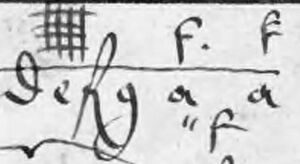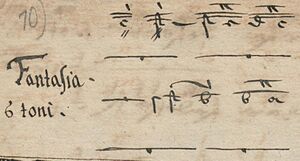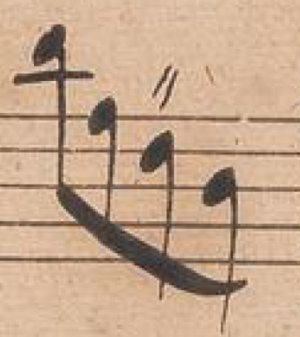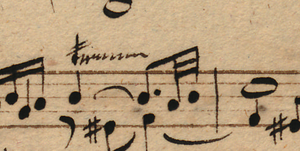Doppelstrich

The double bar or double line (de "Doppelstrich" or "Doppelsenkrechte) is an ornament that appeared primarily in Baroque music in northern Germany.
Appearence

Like all ornaments in New German Tablature, the Doppelstrich appears below the note which it applies to. It appears as two parallel lines either vertical or rotated slightly clock-wise.

The Doppelstrich occasionally appears in German manuscripts in stave notation. Here it usually appears above or below the note, and not intersecting the stem of the note as in English virginal music[Citation needed].

Additionally, an interesting ornament appears in D-B Mus.ms. 30280 which appears to be a notehead with a Doppelstrich intersecting the stem.[1]
Execution
Due to the lack of scientific results, no generally valid rules can be established for a historically correct execution of this ornament. However, there are some testimonies from the area of the North German organ school, which allow an approximation to the practices of that time. One of the most important findings is a possible adaptation of the length of an ornament to the length of the underlying note. Michael Praetorius' Syntagma musicum (1619), Johann Adam Reincken's Hortvs Musicvs (1687) and explanations by Martin Heinrich Fuhrmann (1669-1745) show that trills - or "trillo" or "tremuli" - begin with the main note. A correspondence of the symbol || with Jan Pieterszoon Sweelinck's // is obvious and requires a situation-dependent execution on the basis of the flow direction of the music, but also presupposes a beginning with the main note. However, a performance with a beginning secondary note is conceivable in later works of the North German organ school as in Vincent Lübeck.[2][3] Also the Hamburg manuscript S.M.G. 1691 only achieves a beginning of trills with the secondary note around 1710 by means of suggested notes.[4]
In connection with the transmission of Buxtehude's suites and variations, it can be proven that around 1700 the tablature symbols double vertical line, double cross and wavy line were identified as the "agréments" cadence or tremblement, pincement or coulé. With all due caution, one can infer that the symbol of the double vertical line often found in the tablatures signifies an ornament which uses the upper auxiliary note, ... .[5]
References
- ↑ [1] accessed 18 July, 2023
- ↑ Beckmann, K., 2009. Blütezeit und Verfall, 1. Auflage. ed, Die Norddeutsche Schule: Orgelmusik im protestantischen Norddeutschland zwischen 1517 und 1755. Schott, Mainz.
- ↑ Laukvik, J., 1990. Orgelschule zur historischen Aufführungspraxis. Eine Einführung in die „alte Spielweise“ anhand ausgewählter Orgelwerke des 16. bis 18. Jahrhunderts. Carus-Verlag, Stuttgart.
- ↑ Rampe, S., 2003. Vincent Lübeck. Neue Ausgabe sämtlicher Orgel- und Clavierwerke. Bärenreiter-Verlag, Kassel.
- ↑ Beckmann, K (editor). D. Buxtehude: Sämtliche Orgelwerke, Band I-II. Wiesbaden: Edition Breitkopf, 1997. Preface.